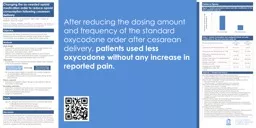

Intervention took place May 1 2019 Women who underwent cesarean delivery in the 6 months preintervention Nov 2018April 2019 were compared to those from the 3 months postintervention MayJuly 2019 ID: 908812
Download Presentation The PPT/PDF document "Study design Prospective, before-after c..." is the property of its rightful owner. Permission is granted to download and print the materials on this web site for personal, non-commercial use only, and to display it on your personal computer provided you do not modify the materials and that you retain all copyright notices contained in the materials. By downloading content from our website, you accept the terms of this agreement.
Slide1
Study design
Prospective, before-after cohort study at a single tertiary care institution, performed primarily for institutional QI
Intervention took place May 1, 2019Women who underwent cesarean delivery in the 6 months pre-intervention (Nov 2018-April 2019) were compared to those from the 3 months post-intervention (May-July 2019)InterventionModification of the standard as-needed opioid order included in the post-cesarean orderset:No changes were made to standard non-opioid analgesics:
Changing the as-needed opioid medication order to reduce opioid consumption following cesarean delivery
Christine McKenzie1, Lacey Straube1, Ben Cobb1, Carolyn M. Webster2, Alison M Stuebe21Division of Obstetric Anesthesia, Department of Anesthesiology and 2Division of Maternal-Fetal Medicine, Department of Obstetrics and Gynecology; The University of North Carolina at Chapel Hill School of Medicine and UNC Health Care
Objective
To evaluate the effect of reducing the dose amount and frequency of the standard as-needed opioid order on opioid consumption and analgesia at a single tertiary care center.
Methods
Results
Use of > 30mg of oxycodone in the 24 hours before discharge: ◦ 15.2% (66/434) pre-intervention group ◦ 5.2% (15/290) post-intervention groupNo differences found in pain scores or hospital length of stay
Discussion
Changing the availability of as-needed oxycodone reduced the number of women requiring > 30mg of oxycodone in the 24 hours prior to discharge without an increase in pain scores. A multimodal regimen of scheduled acetaminophen and NSAIDs is effective for cesarean analgesia with low opioid requirements.
After reducing the dosing amount and frequency of the standard oxycodone order after cesarean delivery, patients used less oxycodone without any increase in reported pain.
Oxycodone 5-10mg every 4 hours PRN
Oxycodone 5mg every 6 hours PRN
Primary outcome
Proportion of patients using > 30 mg of oxycodone in the 24 hours prior to discharge
Secondary outcomes
Proportion of patients with pain score > 4/10 (moderate pain)Proportion of patient with pain score > 7/10 (severe pain)Mean postoperative pain scores Length of hospital stay
Table 1. Opioid consumption and analgesia before and after modification of the post-cesarean order setPrimary & Secondary OutcomesPre-Interventionn=434 Post-Interventionn=290Oxycodone use >30mg last 24 hrs, n (%)66 (15.2)*15 (5.2)Oxycodone use >20mg last 24 hrs, n (%)132 (30.5)*52 (18.0)Oxycodone total last 24 hours (mg), median (IQR)5 (0, 20)5 (0, 15)At least 1 pain score > 4 (moderate pain) last 24 hours, n (%)355 (81.8)240 (82.8)At least 1 pain score > 7 (severe pain) last 24 hours, n (%)200 (46.1)125 (43.1)Average pain score during hospitalization, mean (SD)2.8 (1.6)2.7 (1.6)*p<0.05
ALL POST-CESAREAN PATIENTS (unless contraindicated)
Ibuprofen 600mg Q6 hours (option for ketorolac 30mg for first 24 hours) Acetaminophen 650mg Q6 hours (first dose is 1000mg) PRNs FOR THE “STANDARD” PATIENT WHO RECEIVED NEURAXIAL OPIOID Oxycodone 5mg Q6 hours prnLidocaine patch 1-2 patches placed on the abdomenPRNs FOR PATIENTS WHO RECEIVED GENERAL ANESTHESIA Consider truncal block +/- exparel Fentanyl 25mcg Q5 mins max dose 200mcg in PACUConsider long-acting morphine or hydromorphone prn in PACU Oxycodone 5-10mg Q6 hours prn (PACU and post-op)If pain is inadequately controlled in PACU requiring multiple boluses of IV opioids, discontinue all prn opioids and place patient on opioid PCA (morphine or hydromorphone). Evaluate PCA use at 12-24 hours and transition off PCA. CHRONIC OPIOID USERS OR OPIOID REPLACEMENT THERAPY Consider increasing neuraxial opioid doseDiscuss truncal blocks with patient for postoperative pain management Oxycodone 5-10mg Q4-6 hours as needed (dosing interval individualized based on provider discretion) INADEQUATE PAIN CONTROL Consider rescue truncal blocks +/- exparel Ensure non-opioids maximized (NSAIDs, acetaminophen, lidocaine patch) Increase oxycodone dose to oxycodone 5-10mg q6 hours Increase oxycodone frequency oxycodone 5-10mg q4 hours Consider adding additional as-needed NSAID (ibuprofen 200mg Q6 hours) Consider alternate oral opioid (hydromorphone 2-4mg q4 hours prn)
Appendix 1. Detailed Pain Protocol
Acetaminophen 650mg every 6 hoursIbuprofen 600mg every 6 hours (or ketorolac 30mg for the first 24 hours)
Tables & Figures
Figure 1. Opioid consumption before and after modification of the post-cesarean order set